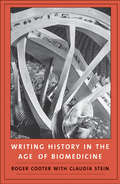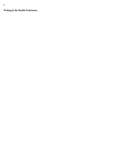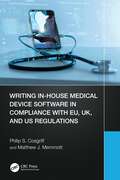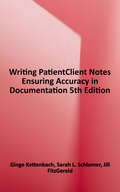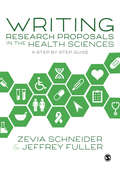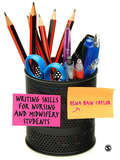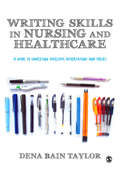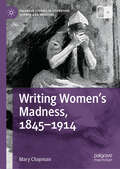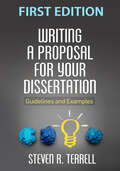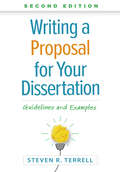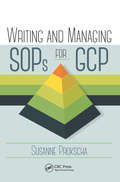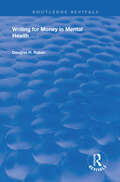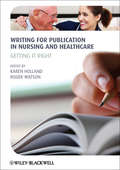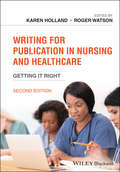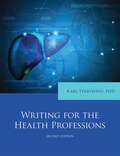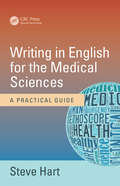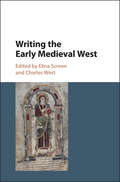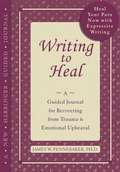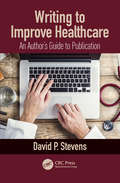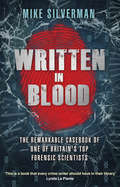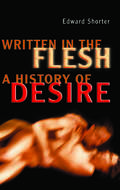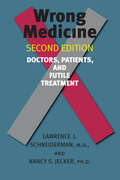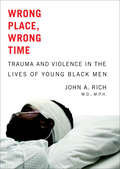- Table View
- List View
Writing History in the Age of Biomedicine
by Roger Cooter Claudia SteinA collection of ten essays paired with substantial prefaces, this book chronicles and contextualizes Roger Cooter's contributions to the history of medicine. Through an analysis of his own work, Cooter critically examines the politics of conceptual and methodological shifts in historiography. In particular, he examines the "double bind" of postmodernism and biological or neurological modeling that, together, threaten academic history. To counteract this trend, suggests Cooter, historians must begin actively locating themselves in the problems they consider.The essays and commentaries constitute a kind of contour map of history's recent trends and trajectories--its points of passage to the present--and lead both to a critical account of the discipline's historiography and to an examination of the role of intellectual frameworks and epistemic virtues in the writing of history.
Writing In The Health Professions
by Stuart Brown Barbara HeifferonPractical, applied, and up-to-the-minute, Writing for the Health Professions teaches students, healthcare professionals, and professional writers the essential skills in medical and health communications. Drawing on her extensive experience as a nurse, cardio-pulmonary technician, medical writer, and writing teacher, Barbara Heifferon addresses the communications requirements of the healthcare professions and those who write in these high-tech fields. This comprehensive text covers writing situations and documents common in hospitals, clinics, HMOs, health insurance companies, public health campaigns, and other healthcare environments. Special attention is given to visual and electronic forms of communication, including web sites and multimedia productions.
Writing In-House Medical Device Software in Compliance with EU, UK, and US Regulations
by Philip S. Cosgriff Matthew J. MemmottThis book is a comprehensive guide to producing medical software for routine clinical use. It is a practical guidebook for medical professionals developing software to ensure compliance with medical device regulations for software products intended to be sold commercially, shared with healthcare colleagues in other hospitals, or simply used in-house.It compares requirements and latest regulations in different global territories, including the most recent EU regulations as well as UK and US regulations.This book is a valuable resource for practising clinical scientists producing medical software in-house, in addition to other medical staff writing small apps for clinical use, clinical scientist trainees, and software engineers considering a move into healthcare. The academic level is post-graduate, as readers will require a basic knowledge of software engineering principles and practice.Key Features: Up to date with the latest regulations in the UK, the EU, and the US Useful for those producing medical software for routine clinical use Contains best practice
Writing Patient/Client Notes: Ensuring Accuracy in Documentation
by Ginge Kettenbach Sarah L. Schlomer Jill FitzGeraldMaster the hows and whys of documentation! Develop all of the skills you need to write clear, concise, and defensible patient/client care notes using a variety of tools, including SOAP notes. <p><p>This is the ideal resource for any health care professional needing to learn or improve their skills--with simple, straightforward explanations of the hows and whys of documentation. It also keeps pace with the changes in Physical Therapy practice today, emphasizing the Patient/Client Management and WHO's ICF model.Section by section you'll learn how to document clearly and accurately, while exercise by exercise you'll practice mastering every step.
Writing Research Proposals in the Health Sciences: A Step-by-step Guide
by Zevia Schneider Jeffrey FullerThis is your step-by-step guide on how to write successful research proposals in the health sciences, whether it is for a thesis or dissertation review committee, an ethical review committee or a grant funding committee. Using quantitative, qualitative, and mixed research approaches, follow the journey of Liang and Natasha, two fictional researchers who will help you complete your proposal alongside reading the chapters. This practical guide includes top tips from the authors, read-reflect-respond activities and examples of project plans to equip you with all the tools you need to succeed with your research proposal.
Writing Research Proposals in the Health Sciences: A Step-by-step Guide
by Zevia Schneider Jeffrey FullerThis is your step-by-step guide on how to write successful research proposals in the health sciences, whether it is for a thesis or dissertation review committee, an ethical review committee or a grant funding committee. Using quantitative, qualitative, and mixed research approaches, follow the journey of Liang and Natasha, two fictional researchers who will help you complete your proposal alongside reading the chapters. This practical guide includes top tips from the authors, read-reflect-respond activities and examples of project plans to equip you with all the tools you need to succeed with your research proposal.
Writing Skills for Nursing and Midwifery Students
by Dena Bain TaylorNursing and midwifery students are required to communicate in writing in a variety of forms, for a variety of potential audiences including their colleagues, allied health professionals, administrators and, most importantly, their patients and the public. Dena Bain Taylor is an experienced teacher of writing and critical skills across the range of allied health professions, and understands the types of writing nursing and midwifery students do and the writing issues they face. Her accessible, straightforward book - tailored specifically to the content and conventions of nursing and midwifery curricula - teaches students to write persuasively and correctly, both to support them in their courses and to prepare them for their professional careers. The book: - offers practical strategies for using language to achieve clear, persuasive writing; - provides clear explanations of underlying principles; - contains samples of good and improvable writing, leading the student step-by-step through the whole writing process; - focuses on the genres and styles of writing that nursing and midwifery students are typically asked for. With regular summaries, learning aids, checklists and a glossary of key terms, nursing and midwifery students at all levels will find this book easy to follow and handy to refer to for help with the writing they need to do throughout their course.
Writing Skills in Nursing and Healthcare: A Guide to Completing Successful Dissertations and Theses
by Dena Bain TaylorDeveloping persuasive, clear, authoritative writing for academic and professional work can be a real challenge for many. This book guides the reader through the writing process for a dissertation, thesis or essay. Practical strategies and tips for each stage of the process are offered throughout, from critical reading through to preparing the final piece of work for submission. The author pays particular attention to an understanding of the English language, and how it is be best used in academic work. Key features of the book are: Real examples from postgraduate work which show the strengths and weaknesses of different approaches Glossaries of terms Case studies of published research which demonstrate good practice in writing Checklists of tasks to complete whilst working on a writing project It will be essential reading for all those writing dissertations, essays and theses at post-registration and postgraduate level in health and nursing.
Writing Skills in Nursing and Healthcare: A Guide to Completing Successful Dissertations and Theses
by Dena Bain TaylorDeveloping persuasive, clear, authoritative writing for academic and professional work can be a real challenge for many. This book guides the reader through the writing process for a dissertation, thesis or essay. Practical strategies and tips for each stage of the process are offered throughout, from critical reading through to preparing the final piece of work for submission. The author pays particular attention to an understanding of the English language, and how it is be best used in academic work. Key features of the book are: Real examples from postgraduate work which show the strengths and weaknesses of different approaches Glossaries of terms Case studies of published research which demonstrate good practice in writing Checklists of tasks to complete whilst working on a writing project It will be essential reading for all those writing dissertations, essays and theses at post-registration and postgraduate level in health and nursing.
Writing Women's Madness, 1845-1914 (Palgrave Studies in Literature, Science and Medicine)
by Mary ChapmanTaking an interdisciplinary approach, this book bridges literary studies and the history of medicine to offer a unique perspective on female mental illness in the nineteenth century. Demonstrating the importance of writing to psychiatric practice during this period, the book moves forward from previous asylum-focused scholarship, to uncover how written discourse was integral to the creation and development of theories about the female mind. During the Victorian era, cultural beliefs about femininity combined with an emerging physiological understanding of mental illness to produce a concept of female madness centred on reproductive biology. Exploring the textuality of clinical literature and periodicals, the book shows how their genre, form, language, and readership shaped the development of gendered psychiatric theory. Covering nineteenth-century print culture, a range of popular and specialist periodicals, and delving into little explored sources in the history of psychiatry, the book examines key topics of interest such as the mind sciences in the popular press; the publishing history of psychiatric textbooks; patient literature in asylum periodicals; and the early treatment of mental illness at the turn of the twentieth century. The book will appeal to researchers working in the fields of periodical studies, women's history, and the history of psychiatry, as well as scholars interested in the medical humanities more broadly.
Writing a Proposal for Your Dissertation
by Steven R. TerrellThis user-friendly guide helps students get started on--and complete--a successful doctoral dissertation proposal by accessibly explaining the process and breaking it down into manageable steps. Steven R. Terrell demonstrates how to write each chapter of the proposal, including the problem statement, purpose statement, and research questions and hypotheses; literature review; and detailed plan for data collection and analysis. Of special utility, end-of-chapter exercises serve as building blocks for developing a full draft of an original proposal. Numerous case study examples are drawn from across the social, behavioral, and health science disciplines. Appendices present an exemplary proposal written three ways to encompass quantitative, qualitative, and mixed-methods designs. Pedagogical Features: *"Let's Start Writing" exercises leading up to a complete proposal draft. *"Do You Understand?" checklists of key terms plus an end-of-book glossary. *End-of-chapter quizzes with answers. *Case study examples from education, psychology, health sciences, business, and information systems. *Sample proposal with three variants of the methods chapter: quantitative, qualitative, and mixed methods.
Writing a Proposal for Your Dissertation: Guidelines and Examples
by Steven R. TerrellThe encouraging book that has guided thousands of students step by step through crafting a strong dissertation proposal is now in a thoroughly revised second edition. It includes new guidance for developing methodology-specific problem statements, an expanded discussion of the literature review, coverage of the four-chapter dissertation model, and more. Terrell demonstrates how to write each chapter of the proposal, including the problem statement, purpose statement, and research questions and hypotheses; literature review; and detailed plans for data collection and analysis. "Let's Start Writing" exercises serve as building blocks for drafting a complete proposal. Other user-friendly features include case-study examples from diverse disciplines, &“Do You Understand?&” checklists, and end-of-chapter practice tests with answers. Appendices present an exemplary proposal written three ways to demonstrate quantitative, qualitative, and mixed methods approaches, and discuss how to structure a four-chapter dissertation. New to This Edition *Introduction offering a concise overview of the entire proposal-writing process and the doctoral experience. *Additional help with tailoring problem and purpose statements for quantitative, qualitative, and mixed-methods studies. *Expanded discussion of the review of literature, including a criterion for judging the quality of primary versus secondary sources. *Many new examples from different disciplines, such as studies of depression treatments, approaches to reducing offender recidivism, health effects of irradiated crops, strength training in college football, and remote teaching and learning during COVID-19. *Focus on the five-chapter model is broadened to include specific guidance for four-chapter dissertations. *Broader, more detailed reference list and glossary.
Writing and Managing SOPs for GCP
by Susanne ProkschaThis book discusses managing SOPs for GCP from conception to retirement. It recommends approaches that have a direct impact on improving SOP and regulatory compliance. Throughout the text, the book provides a user's point of view to keep topics focused on the practical aspects of SOPs and SOP management.
Writing for Money in Mental Health
by William Winston Douglas H RubenOffering a simple-to-follow roadmap for scholars, practitioners, and journalists seeking payable markets for their works, Writing for Money in Mental Health is your authoritative guide to the inner circle of writing for dollars on mental health topics. For psychiatrists; psychologists; occupational, physical, and vocational therapists; allied health practitioners; and journalists specializing in mental health topics, this book guides you through the obstacles of choosing topics, locating suitable placements, meeting submission criteria, and facing the fear of rejection. The book's focus on how to write stimulating articles and book proposals, translate technical jargon into plain English, and stay up to date with insider tips will help you supplement your paycheck in a time of shrinking referrals, clients, and opportunities for income.As the first complete handbook for aspiring professionals seeking consumer and commercial outlets for their writing, Writing for Money in Mental Health describes proven strategies for low and high profit results in scripting mental health ideas without painstaking effort. You'll use this handy guide to discover: how to write for money instead of pure scholarship how to alter your style for the consumable public market new markets in multimedia typically overlooked in mental health writing nontraditional paths to publication how easy writing for the public can be--especially for moneyAlong with inspirational instruction and invaluable trade secrets at the heart of manuscripts sales, each chapter provides you with a detailed list of resources. These annotated entries, culled from questionnaires returned from editors, publishers, and other media personnel, list key editorial data on magazines, book publishers, and other multimedia purchasers open to submissions in the mental health field whose products are for tabloid or mass appeal.
Writing for Publication in Nursing and Healthcare
by Roger Watson Karen HollandWriting for Publication in Nursing and Healthcare is an invaluable guide to 'getting it right', focusing on all aspects of writing for publication. It will help the reader to develop skills in writing articles, book reviews and other forms of publications, and can also be used as an aide-mémoire for editors and journal or book reviewers. It explores:How to get startedHow to write various forms of publication including abstracts, papers, book reviews, journal articles and booksGood practice in reviewingThe editorial processEthical and legal aspects of publishingOffering guidance, tips, examples and activities, this practical how-to book written by experts in the field is essential reading for all nurses and healthcare professionals.
Writing for Publication in Nursing and Healthcare: Getting it Right
by Roger Watson Karen HollandWriting for Publication in Nursing and Healthcare helps readers develop the skills necessary for publishing in professional journals, presenting conference papers, authoring books, research reports, and literature reviews, and more. This comprehensive resource covers all aspects of writing for publication, including good practice in reviewing, the editorial process, ethical aspects of publishing, and the rules that govern academic writing, publishing, and dissemination. Assuming no prior expertise in the subject, the text uses an accessible, step-by-step approach that incorporates a wealth of real-life examples, hands-on activities, and valuable tips throughout. The second edition reflects the latest developments, guidelines, and practices both in academic publishing and in research assessment and dissemination. New and updated material covers the increasing use of social media to disseminate published work, post-publication scrutiny, contemporary issues surrounding predatory or unethical publishers, and new requirements for research registration and submission data. Edited by leading experts in the field, this practical ‘how to’ guide: Describes the basics of writing for publication and how to get started Includes numerous examples illustrating the practical ways abstracts, papers, book reviews, and other publications are written and disseminated Discusses current issues and developments, such as the impact of major ethics organisations on publishing worldwide and the rise of online journals, blogging, and podcasting Features contributions by internationally recognised academics and practitioners Explains how to turn research reports and other assignments into publishable works The definitive introduction to the subject, Writing for Publication in Nursing and Healthcare is a must-have for all nurses and healthcare professionals, as well as undergraduate and graduate students in nursing and healthcare programs who are required to write for publication.
Writing for the Health Professions
by Karl TerryberryWriting for the Health Professions (updated second edition) is an ideal companion for students in allied health programs, and a valuable reference guide for health professionals. This book teaches the principles of writing for the health professions and guides the reader through the fundamentals of writing essays, professional papers, documentation and research grants. This book can be used in a variety of ways, including in writing class for health care students, a reference text for students during their academic years, or as a resource guide for the practicing professional. Writing for the Health Professions assumes the reader has a working knowledge of basic language skills and builds on those skills with a functional approach to grammar, usage and style for medical-related topics and issues directly related to the professional health services environment. Throughout the book every chapter includes a variety of exercises and examples to promote student engagement and learning about writing for the health professions.
Writing in English for the Medical Sciences: A Practical Guide
by Steve HartThis practical and portable guide has been designed specifically to help academics and students in medicine and surgery departments at universities all over the world, who are required to write in English to maximize exposure to their research, produce professional and accurate academic English and eradicate the errors that occur at all levels from bad habits or gaps in knowledge. By identifying likely mistakes and then instructing the writers on how to correct them, with exercises to encourage self testing, this easily accessible and at-a-glance resource can be kept readily to hand as an invaluable companion during the course of writing an essay, thesis or paper.
Writing the Early Medieval West
by Charles West Elina ScreenFar from the oral society it was once assumed to have been, early medieval Europe was fundamentally shaped by the written word. This book offers a pioneering collection of fresh and innovative studies on a wide range of topics, each one representing cutting-edge scholarship, and collectively setting the field on a new footing. Concentrating on the role of writing in mediating early medieval knowledge of the past, on the importance of surviving manuscripts as clues to the circulation of ideas and political and cultural creativity, and on the role that texts of different kinds played both in supporting and in subverting established power relations, these essays represent a milestone in studies of the early medieval written word.
Writing to Heal: A Guided Journal for Recovering from Trauma and Emotional Upheaval
by James W. PennebakerThis book takes readers through a series of guided writing exercises that help them explore their feelings about difficult experiences. Each chapter begins with an introduction that explains how to proceed with journal exercises and what they are structured to help accomplish. The exercises leave readers with a strong sense of their value in the world.
Writing to Improve Healthcare: An Author’s Guide to Scholarly Publication, First Edition
by David P. StevensThis new book is a 'what and how to' guide to writing for successful scholarly publication in the emerging fields of healthcare improvement and patient safety. While there are many useful authors’ aids for scholarly biomedical publication, none focuses explicitly on these relatively new fields. It offers practical advice that includes preparation and organization of a scholarly healthcare improvement manuscript, where to submit it to find the most likely interested editor and journal, how to take full advantage of coauthors’ working together effectively, and strategies for authors to reach a broader health professions readership.
Written in Blood
by Tony Thompson Mike SilvermanAs one of the UK’s leading forensic scientists, Mike Silverman has helped to identify and convict dozens of murderers, rapists, armed robbers, burglars and muggers, thanks to the evidence they – or their victims – unwittingly left behind at the scenes of their crimes. Mike Silverman started his career in the days when fingerprints were still kept on card files and DNA profiling was just a pipe dream, so Written in Blood is more than just a casebook – it is also a definitive history of the development of forensic science over the course of the past thirty-five years.From collecting blood samples at gangland executions to investigating forensic science failings, including in the murders of Rachel Nickell and Damilola Taylor, Mike Silverman’s unique career provides a fascinating insight into the ways forensic science is used to help solve real-life crimes. Packed with genuine crime scene photographs and original sketches, Written in Blood is the ultimate insider’s account of the fascinating world of forensic science.
Written in the Flesh
by Edward ShorterWritten in the Flesh is a history of sexual desire - a startling and provocative history of what people yearn to do sexually. It is the story of the whole body's need for sexual attention rather than simply the genitalia and their procreational function.The desire for sexual pleasure and total body sex - that is, the expansion of sexuality from a limited focus on the face and genitals to include the entire body - is certainly not a new phenomenon: the ancient Greeks, Romans, and Chinese, amongst others, were quite familiar with eroticism that went beyond the strictly heterosexual and procreational. In the long centuries of Christian Europe, when miserable conditions of life and religious repression conspired to minimize the expression of sexual longing, desire was driven underground. Yet in the late nineteenth century, increasing privacy, prosperity, and good health again permitted the underlying biological urge for total body sex to express itself, and encouraged a shift of erotic pleasure toward new and unexplored body zones: the mouth, nipples, anus, and further.This new work by renowned medical historian Edward Shorter demonstrates that desire is hard-wired into the brain, expressing itself in remarkably similar ways in men and women, adolescent and adult, and in gays, lesbians, and straights alike. Drawing from a wide array of sources, including memoirs, novels, collections of letters, diaries, and indeed a large pornographic corpus, Shorter explores the widening of Western society's sexual repertoire. Written in the Flesh is a history of what people like to do in bed and how that has changed. The change is relentless: human sexuality continually seeks new means of liberation in its expression of pleasure. Disclaimer: Images removed at the request of the rights holder.
Wrong Medicine: Doctors, Patients, and Futile Treatment
by Lawrence J. Schneiderman Nancy S. JeckerToo often, patients in American hospitals are subjected to painful, expensive, and futile treatments because of a physician’s notion of medical duty or a family’s demands. Lawrence J. Schneiderman and Nancy S. Jecker renew their call for common sense and realistic expectations in medicine in this revised and updated edition of Wrong Medicine.Written by a physician and a philosopher—both internationally recognized experts in medical ethics—Wrong Medicine addresses key topics that have occupied the media and the courts for the past several decades, including the wrenching Terry Schiavo case. The book combines clear descriptions of ethical principles with real clinical stories to discuss the medical, legal, and political issues that confront doctors today as they seek to provide the best medical care to critically ill patients. The authors have added two chapters that outline theoretical, legislative, judicial, and clinical developments since the first edition. Based on the latest empirical research, Wrong Medicine continues to guide a broad range of health care professionals through the challenges of providing humane end-of-life care.
Wrong Place, Wrong Time: Trauma and Violence in the Lives of Young Black Men
by John A. RichNamed One of the Top 20 Books of 2009 by Cleveland Plain DealerMedical school taught John Rich how to deal with physical trauma in a big city hospital but not with the disturbing fact that young black men were daily shot, stabbed, and beaten. This is Rich's account of his personal search to find sense in the juxtaposition of his life and theirs.Young black men in cities are overwhelmingly the victims—and perpetrators—of violent crime in the United States. Troubled by this tragedy—and by his medical colleagues' apparent numbness in the face of it—Rich, a black man who grew up in relative safety and comfort, reached out to many of these young crime victims to learn why they lived in a seemingly endless cycle of violence and how it affected them. The stories they told him are unsettling—and revealing about the reality of life in American cities.Mixing his own perspective with their seldom-heard voices, Rich relates the stories of young black men whose lives were violently disrupted—and of their struggles to heal and remain safe in an environment that both denied their trauma and blamed them for their injuries. He tells us of people such as Roy, a former drug dealer who fought to turn his life around and found himself torn between the ease of returning to the familiarity of life on the violent streets of Boston and the tenuous promise of accepting a new, less dangerous one.Rich's poignant portrait humanizes young black men and illustrates the complexity of a situation that defies easy answers and solutions.
